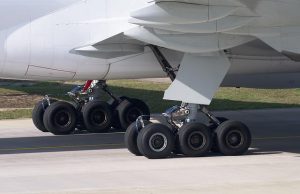
Airplanes feature inflated tires that are able to absorb the shock of landing on a runway. Unlike the tires on cars and trucks, though, they aren’t inflated with air.
Most airplanes feature nitrogen-inflated tires. Nitrogen gas is pumped into the tires until a specific pounds per square (PSI) of pressure is reached. Whether narrow-body or wide-body, nearly all airplanes have nitrogen-inflated tires. Nitrogen offers several benefits when used to fill airplane tires.
Keeps Out Moisture
Nitrogen keeps moisture out of airplane tires. Regular atmospheric air contains moisture. If used to fill airplane tires, air will introduce moisture. Moisture will enter airplane tires where it causes other problems. Filling airplane tires with nitrogen prevents moisture from entering them.
Protects Against Corrosion
Because it keeps out moisture, nitrogen protects airplane tires against corrosion. Airplane tires can succumb to corrosion. Moisture will facilitate oxidation within airplane tires, thus causing them to corrode from the inside out.
Assuming it’s pure, nitrogen won’t contain any moisture. Therefore, it protects airplane tires against corrosion. Airplane tires are sealed. They can be pumped with nitrogen without introducing moisture. And with nitrogen, corrosion isn’t a concern.
Promotes Consistent Pressure
Another reason nitrogen is used to fill airplane tires is because it promotes consistent pressure. The pressure of an airplane’s tires may vary depending on the altitude. As the airplane ascends, the pressure of its tires may change. This is due mostly to the moisture vapor freezing. The moisture vapor inside of the tires will freeze, thereby creating inconsistent pressure.
Nitrogen doesn’t contain moisture, so it promotes consistent pressure. Airplane tires filled with nitrogen may experience some minor fluctuations in tire pressure, but the PSI will remain relatively stable.
Nonflammable
It’s also worth noting that nitrogen is a nonflammable gas. Pure oxygen can be moisture-free as well, but oxygen is a highly flammable gas. When exposed to a heat source, it can ignite. If this ignition occurs inside of a tire, it may cause the tire to explode.
Nitrogen offers a safe and effective alternative to oxygen. As a nonflammable gas, it won’t ignite when exposed to a heat source.
In Conclusion
Since the late 1980s, the U.S. Federal Aviation Administration (FAA) has required commercial airplanes to use nitrogen in their tires rather than air or oxygen. Nitrogen keeps out moisture, protects against corrosion, promotes consistent pressure and is nonflammable.



